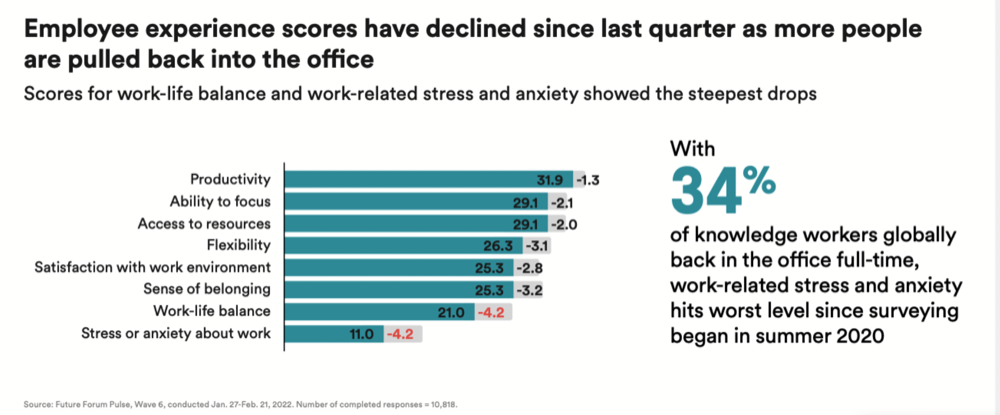Apple’s hybrid working policies don’t work and must change

Across the last two years of isolation, we’ve learned the importance of family and community, that flexibility counts, and a fair day’s work doesn’t need to happen in the office but can take place wherever you are.
Employers are resisting the inevitable
Sadly, many employers, including Apple, are attempting to turn back the clock and return us to a commuter lifestyle no one wants to exist inside anymore.
This pattern is emerging all over the world.
Employers seem obsessed with dumb ideas around presence and are attempting to force workers to abandon their homes and families to sit in offices for hours doing what they’ve been doing quite successfully at home for two years. That this is happening as global elites cement control across the planet may be related. Perhaps the officer class don’t want to give workers even an iota of autonomy?
But what they want may not matter much.
Employees want to do their best work their way, and the Great Resignation shows how workers can, will, and are voting with their feet.
Archaic management practices are facing huge resistance.
Faced with a choice between fixed office hours and flexible autonomy, workers are quitting in droves, including at Apple.
They’ve thought about what they want to do with their lives and in many cases, this doesn’t include staring at the pens on their desk while counting the hours until they can squeeze in beside some COVID-infected commuter to make the long journey home.
They don’t want to do that anymore.
Four out of five professionals are considering looking for another job in the next three months.

Apple employees want to do their best work their way
Apple always says it wants to encourage employees to do their best work but has proposed an incredibly inflexible hybrid working model in which staff must be in the office Mondays, Tuesdays, and Thursdays during the week, This closes the door on so many different routes to flexibility, and almost certainly impacts diversity.
I think it’s nuts.
Over the last two years we have seen Apple generate record profits even while the pandemic forced its people to do their best work at home. Apple’s staff have shown what they can do when given such autonomy – and it makes no sense to me that Apple wants to take that away.
It makes no sense to employees either. It seems three out of four verified Apple employees (76%) are dissatisfied with these return-to-office plans, according to a recent survey of 652 verified US Apple professionals from Blind.
Staff are so unhappy at Apple’s attitude that as many as half of them may quit the company, the report claims.

Future Forum sees a massive decline in employee experience satisfaction
Some have got together to start a group called Apple Together who have published an open letter criticizing the company’s plans.
Listen to the smart people you hire, say employees
“We ask you, the executive team, to show some flexibility as well and let go of the rigid policies of the Hybrid Working Pilot. Stop trying to control how often you can see us in the office. Trust us, we know how each of our small contributions helps Apple succeed and what’s required to do so. Our direct managers trust us and in many cases would happily let us work in a more flexible setup. And why wouldn’t they, we’ve successfully done so for the last two years. Why don’t you?
Or as Steve said:
“It doesn’t make sense to hire smart people and then tell them what to do. We hire smart people so they can tell us what to do.” Here we are, the smart people that you hired, and we are telling you what to do: Please get out of our way, there is no one-size-fits-all solution, let us decide how we work best, and let us do the best work of our lives.”
Writing on Blind, one employee wrote “Apple is going to see attrition like no other come June. 60% of my team doesn’t even live near the office. They are not returning.”
What most alarms me about what Apple is doing, given the wider context of my work exploring the nature of the new workplace, is the disconnect between what Apple says and what it does.
You see, Apple says it values its people and yet has failed to understand the need to design employee experiences that make people happy.
Instead, it has arrived at a dumb compromise that is upsetting its teams.

Apple’s (talent) war of attrition
The effect of that decision is that 58% of Apple staff know people who have already quit because of it.
“Leadership is tone deaf,” said one verified Apple professional on Blind.
I can’t help but agree.
I’ve been writing about changing working practise throughout the pandemic (and before), and believe the impact of these changes will be as profound and long-lasting as the impact of BYOD and the digital transformation of business.
We don’t want to go back to the office.
To persuade us to do so, employers will need to come up with compelling reasons that empower and delight people, rather than reducing their autonomy and making them feel disempowered.
As Apple Together writes:
“We are not asking for everyone to be forced to work from home. We are asking to decide for ourselves, together with our teams and direct manager, what kind of arrangement works best for each one of us, be that in an office, work from home, or a hybrid approach. Stop treating us like school kids who need to be told when to be where and what homework to do.”

The crazy ones didn’t want to go back to the office, either
This is an employee experience design challenge
Apple need to approach this as a product design problem.
If there is a new future of work, why shouldn’t it be invented at Apple, and reflect the needs, desires, and considerable achievements of its smart staff?
What’s wrong with harnessing the power of remote work to improve diversity and enable workers to juggle complex workloads alongside complex life challenges? Why not use innovative solutions such as Flow Club to create those energy vortexes remotely but internally?
Designing the new workplace will not involve listening to Apple’s senior management. Just like everything else in digital disruption, the ideas will come from the people doing the work.
“Leaders need to move away from dictating days in the office and rigid 9-to-5 schedules, and focus instead on aligning their teams around a common purpose and leading by example,” said Brian Elliott, Executive Leader of the Future Forum recently.
I agree.
I really think Apple has a blind spot here.
It needs to think different about its approach. The Crazy Ones don’t want to do this any more.
Please follow me on Twitter, or join me in the AppleHolic’s bar & grill and Apple Discussions groups on MeWe.




